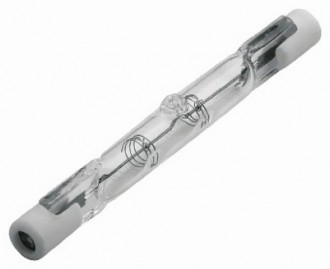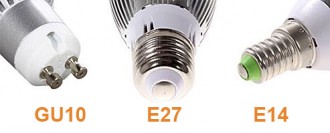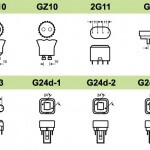What are the lamp bases?

Today, there are many sizes and types of socles of lighting lamps, which we will talk about in more detail now.
Marking
The oldest type is threaded, which was invented by Thomas Edison at the end of the 19th century (index E). In addition, there are the following markings of lamp caps:
- G - pin;
- R - with recessed contact;
- F - with one pin (a - cylindrical, b - grooved, c - special shape);
- B - pin;
- S - spotlight;
- K - with cable connection;
- P - focusing;
- H - for xenon bulbs;
- T - telephone;
- W - current inputs are located in the glass of the bulb.
We draw your attention to the fact that in addition to one of these letters one more can be attached: U, V or A, which means respectively for energy-saving lamps, with a conical end or a car type.
The following is a digital marking showing the diameter of the cap or the distance between the two pins, (in mm). After the number, the number of connections (flexible, plates or pins) can be indicated. For this, the letters s, d, t, q, p are used, which mean 1, 2, 3, 4 or 5 contacts.
Now we will take a closer look at the main characteristics of all household types of lamp base caps and the conditions for their use
Characteristic
Threaded (E). Despite the fact that it appeared the very first one almost a century and a half ago, this species has not lost its popularity until today. This is due to the simple and convenient design, which allows you to screw the flask in seconds. Now these types of socles can be installed in all types of bulbs: LED, halogen, fluorescent and, of course, incandescent. As for the types of threaded socles, they can have the following diameters according to GOST: 5 mm (E5), 10 mm (E10), 12 mm (E12), 14 mm (E14, minion), 17 mm (E17), 26 mm ( E26), 27 mm (E27, normal), 40 mm (E40). At home, usually less than E14 is not used.
Pin (G). Commonly used in halogen, LED and fluorescent light sources. The design is represented by pins, which are also easily and quickly connected to the network. A variety of products is the distance between the pins, as well as their number. For example, type G4 means that the distance is 4 mm, and G5.3, respectively, 5.3 mm. The disadvantage of this design is that it will be difficult for a novice electrician to determine which cap size to buy (for example, when a daylight lamp fails), so you will need to go to the store with a broken example.
With recessed contact. This type of lamp base is used in lighting with tubular quartz and halogen light sources, which have a high heating temperature and power.
We draw your attention to the fact that in the marking of these products there may be a figure (for example, 118). It means the full length of the entire product.
Spotlight (S). This type is most often used when installing lighting in the bathroom, as well as for illuminating mirrors. The designation S6 or S8.5 means that the case diameter is 6 (8.5) mm.
Pin (B). This type has an operating principle similar to a threaded one. The only difference is that a threaded connection needs a thread, and in this case two pins are used, installed opposite each other in the outer diameter of the base. This design simplifies connecting the lamp to the network. The main field of application is automotive lighting. Marking is carried out as follows: BA - the pins are installed symmetrically, BAZ - one of the pins is offset in radius and height, BAY - the offset occurred only in radius. The number indicates the case diameter in mm.
Focusing (P). Its design is represented by a lens, with the help of which the light flux is focused (an unusual shape is visible in the photo). Most often, this type of base is used in automotive lighting, as well as in spotlights and streetlights. Digital marking displays the diameter, in the place where the lamp is installed, or the size of the flange that focuses the light flux.
Telephone (T). It can be used to illuminate electrical appliances in the car, as well as for signal lights in automatic control panels. Digital marking, displays the width of the contact plate (in mm).
As for the rest, they are used extremely rarely, and the marking itself may even be absent. In this case, the type of the lighting lamp itself is indicated, by which the size and type of the base are already determined.
Exceptions
As we have already said, some of the types of lamp caps may not be marked, instead of which the signs will only appear on the light source itself. In this case, you can determine the size only by the marks on the product.
To your attention the main markings:
- MR16 - halogen lamphaving a reflector. In it, as a rule, a pin base is installed (index G).
- R50 - reflex, with a threaded lock in the lampshade (E).
- 2D - LED (CFL) with pins for connection.
I would also like to pay attention to linear fluorescent tubes. The diameter of their tube determines the size of the cap. There are tubular flasks having sizes T5, T8, T12 and T15, the diameter of which is respectively: 1.59 cm; 2.54 cm; 3.17 cm; 3.80 cm.
Popular
For incandescent lamps the most popular are 2 types of threaded caps: E14 (minion) and E27 (standard).
For spotlights, a pin (GU10 or G13) and a threaded view (E14 and E27) are used.
The fluorescent lamp device may include such types of caps as G13, G23, G24, G53.
Halogen lamps most often use sizes G4, G9 and R7s (the latter option is installed in quartz light sources.
- G9
- G4
So you got acquainted with the existing types and sizes of socles of lighting lamps. We hope that the information was available, and most importantly - useful!
Also read:




















